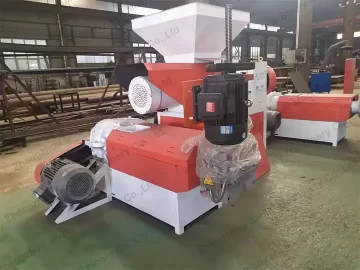The production of high-quality pellets using plastic granulator is critical to manufacturing a wide range of plastic products. However, common production problems can lead to low-quality pellets, production delays, and even equipment damage.
In this article, we will discuss the causes and solutions to three common problems that can occur during the production of plastic granulator.
Black spots on pellets

Black spots on recycled plastic pellets can be caused by a variety of factors, including material degradation, overheating, and material carbonization.
The following are practical solutions to help you solve the problem of black spots on pellets:
- Use quality materials: Quality materials can help prevent black spots on recycled plastic granules.
- Reduce barrel temperature: Overheating can cause material degradation and the formation of black spots.
- Increase screw speed: Increasing screw speed can help improve mixing and prevent material carbonization.
- Pay attention to the production environment and operation process to avoid foreign impurities from being mixed into the raw materials and finished products.
Broken strip problem

Strip breakage in plastic granulator is a common problem that affects the quality of the pellets. There are various reasons for strip breakage, such as high feed rates, high screw speeds, and worn or damaged screws.
The following are practical solutions to help you overcome the problem of broken strips:
- Reduce the feed rate: One of the main causes of strip breakage is excessive feed rate. Reduce the feed rate to a level that the extruder can handle effectively.
- Too large or large a number of screen mesh can trigger resistance to material transport and cause broken strips. This should be done by appropriately adjusting the host speed down or adjusting the feed speed up.
- Check regularly and replace worn or damaged screws as needed: Worn or damaged screws can cause inconsistent mixing, which can lead to broken strips.
- Increase the barrel temperature: Increasing the barrel temperature helps soften the material and reduces the risk of strip breakage.
- Extrusion temperature is low or screw shear is too weak, and material, as well as low melting point additives, are not adequately plasticized, which can also lead to strip breakage at poorly plasticized material during extrusion pelletizing.
Inconsistent particle size

Inconsistency in pellet size is another common problem that occurs during the production of plastic granulator.
This problem can be caused by several factors, such as clogged dies, worn screws, or damaged cutting blades. The following practical solutions can help you overcome this problem:
- Check for clogged dies: Clogged dies can lead to inconsistent particle sizes. If it is clogged, clean it with an appropriate cleaning tool.
- Check the screws: Worn screws can cause inconsistent pellet sizes. Inspect the screws to ensure they are not worn or damaged. If they are worn, consider replacing them.
- Check cutting blades: Damaged cutting blades may cause inconsistent particle sizes. Inspect the cutting blade to ensure it is not damaged. If they are damaged, consider replacing them.
- Adjust the screw speed: The pelletizer’s screw speed affects the length of the discharge, and adjusting the screw speed can help resolve pellet size inconsistencies. You can increase or decrease the screw speed to obtain a consistent pellet size.
- Check the feed rate: An incorrect feed rate can lead to inconsistent pellet sizes. Check the feed rate to make sure it is not too high or too low. Adjust the feed rate as needed to obtain consistent pellet sizes.
In conclusion, the production of plastic granulator is a complex process, which needs to be solved according to the specific situation. In the production process, you should check the equipment status and adjust the operating parameters in time to ensure production efficiency and pellet quality.






